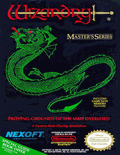
































Wizardry: Proving Grounds of the Mad Overlord

Wizardry: Proving Grounds of the Mad Overlord is the first game in the Wizardry series of role-playing video games. It was developed by Andrew Greenberg and Robert Woodhead. In 1980, Norman Sirotek formed Sir-Tech Software, Inc. and launched a Beta version of the product at the 1980 Boston Computer Convention. The final version of the game was released in 1981.
The game was one of the first Dungeons & Dragons-style role-playing games to be written for computer play, and the first such game to offer color graphics. It was also the first true party-based role-playing video game.
The game eventually ended up as the first of a trilogy that also included Wizardry II: The Knight of Diamonds and Wizardry III: Legacy of Llylgamyn. Proving Grounds needs to be completed in order to create a party that could play in the remainder of the trilogy.
Starting in the town, the player creates a party of up to six characters from an assortment of five possible races (Humans, Elves, Dwarves, Gnomes, Hobbits), three alignments (Good, Neutral, Evil), and four basic classes (Fighter, Priest, Mage, Thief). Besides being the first microcomputer role-playing game to offer multiple characters to control, there are also four elite casses (Bishop: priest and mage spells; Samurai: fighter with mage spells; Lord: fighter with priest spells, and Ninja: fighter with thief abilities). Characters can be changed to an elite class after meeting the stat requirements. Priests typically cast healing spells, while Mages cast damage spells. Bishops, being a combination of the two, learn both sets of spells but at a reduced rate. Good and evil characters normally cannot be assigned to the same party, but exploits exist to allow this.
After equipping the characters with basic armor and weaponry, the party then descends into the dungeon below Trebor's castle. This consists of a maze of ten levels, each progressively more challenging than the last. Classes have multiple spells, each with seven levels, that characters learn as they advance.
The style of play employed in this game has come to be termed a dungeon crawl. The goal, as in most subsequent role-playing video games, is to find treasure including ever more potent items, gain levels of experience by killing monsters, then face the evil arch-wizard Werdna on the bottom level and retrieve a powerful amulet. The goal of most levels is to find the elevator or stairs going down to the next level without being killed in the process.
The graphics are extremely simple by today's standards; most of the screen is occupied by text, with about 10% devoted to a first-person view of the dungeon maze using high-resolution line graphics. By the standards of the day, however, the graphics improved on the text-only games that had been far more common. When monsters are encountered, the dungeon maze disappears, replaced by a picture of one of the monsters. Combat is against from 1 to 4 groups of monsters. The game's lack of an automap feature, which had not been invented at the time of its release, practically forces the player to draw the map for each level on graph paper (included in the box) as he walks through the 20x20 dungeon maze, step by step – failing to do this often results in becoming permanently lost, as there are many locations in the maze that have a permanent 'Darkness' spell upon the square (making the player walk blindly) or a 'Teleport' spell sending the player to a new location. A magic spell can be used to determine the current location of the party, and at higher levels there is a teleport spell that can be used to quickly transition between the maze levels. Care is necessary when teleporting as the player must enter both the level and coordinates to teleport to (the number of steps north, south, east, or west from his current location) and it is easily possible to land in a trap or solid stone, ending the game. The original releases of Wizardry also do not announce that the player has teleported and play resumes as if one step forward was taken.
The game has unforgiving difficulty as players cannot save their progress within the dungeon; they must exit the dungeon first. In the event of a total party kill, play cannot be resumed; however, a new party may recover the bodies and items of dead adventurers. Later Wizardry games made it easier by restarting at the point in the dungeon where the characters died. It can take hundreds of hours to finish the game.
Wizardry saves the player's party and game progress onto a scenario disk. After booting, a new one may be created with a blank floppy disk or an existing one used. Completion of Proving Ground of the Mad Overlord is necessary to play the sequels Wizardry II and III since they require the characters from the first game to be imported from a scenario disk.
How to play:
Click on the joystick icon in the Wizardry: Proving Grounds of the Mad Overlord online emulator to see how to control the Wizardry: Proving Grounds of the Mad Overlord game









































Comments